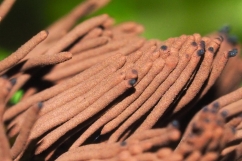| Home | Nature Weekly Index |
8 June 2025 | Chocolate Tube Slime | Stemonitis species |
 |
| Fig. 1: Miniature garden in a container |
The Chocolate Tube Slime (Stemonitis species) was the subject of focus in my first Nature Weekly Short Note started in January 2014. However, the identity of this slime mould at the species level is still unknown.
Its unique appearance is notable. The tall brown sporangia (fruiting or spore-bearing bodies) typically grow in clusters on rotting wood. Recently, it has appeared on a plant in a container where I am creating a miniature garden placed on my balcony area.
The miniature garden in the container (Fig. 1) consists of 5 herbaceous wayside plants that frequently sprout from my pots: Senega paniculata (Root Beer Plant), Oldenlandia corymbosa (Diamond Flower), Dentella repens (Creeping Lickstoop), Peperomia pellucida (Pepper Elder) and Pilea microphylla (Artillery Plant). Apart from the Root Beer Plant, the other four are common wayside plants. The container is approximately 9.5 centimetres in width and 10.5 centimetres in height. The bottom half is filled with coffee waste from 2-in-1 coffee bags, while the upper half is topped up with recycled soil from my pots. The setup was maintained for several months with regular watering to keep the soil moist, resulting in a bushy green mass from spontaneous growth of hidden seeds in the recycled soil.
The Chocolate Tube Slime (Fig. 2) was discovered on 26 May when a dark brown object was observed on a branch of the Pepper Elder. Initially, it appeared to be a decaying part of the plant. However, upon closer inspection, it was identified as a colony of chocolate-coloured Stemonitis species. The colony is present on the surfaces of the leaves and branches of the Pepper Elder, yet there are no visible signs of damage to the host plant. This is the first instance in which I have encountered a slime mould growing on a live plant.
 |
 |
| Fig. 2: Chocolate Tube Slime (Stemonitis species) growing on a Pepper Elder (Peperomia pellucida) | |
Chocolate Tube Slime belongs to the group known as True Slime Molds (Class Myxomycetes) under the Kingdom Protozoa. It should not be confused with mushrooms which belong to the Kingdom Fungi, although both groups may co-exist in the same habitat. A field survey on myxomycetes conducted in three locations in Singapore in 2007 [1] uncovered two Stemonitis species, namely Stemonitis fusca and Stemonitis herbatica. In 2009, a more extensive field survey carried out in 12 locations in Singapore [2] identified 5 Stemonitis species: Stemonitis axifera, Stemonitis fusca, Stemonitis splendens, Stemonitopsis cf. gracilis, and Stemonitopsis typhina. Apart from these two studies, there have been no further publications from Singapore related to Stemonitis species in the past 25 years. According to the iNaturalist website viewed on 8 June 2025, there are 19 observations of Stemonitis species, including two species, namely Stemonitis axifera and Stemonitis splendens.
The website Protists in Singapore includes a section on slime moulds. However, the owner has not updated the page since September 2011. For my additional observations of slime moulds, I have composed another Short Note in September 2014, detailing these organisms encountered during my field trips.
Reference:
[1] Rosing WC. Corticolous myxomycetes of Singapore. Gardens’ Bulletin Singapore 2009;61(1):151-157. | Read article |
[2] Rosing WC, Mitchell DW, Moreno G, Stephenson SL. Additions to the Myxomycetes of Singapore. Pacific Science 2011;65(3):391-400. | Read article |